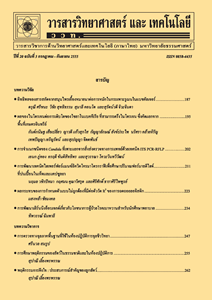วิถีชีวิตที่เป็นปัจจัยเสี่ยงโรคหัวใจและหลอดเลือดของนักศึกษาในมหาวิทยาลัยไทยอยู่ในภาวะวิกฤต ?
Main Article Content
Abstract
บทคัดย่อ
โรคหัวใจและหลอดเลือดเป็นสาเหตุสำคัญของการเจ็บป่วยและการตายของประชากรไทยและประชากรโลก สาเหตุสำคัญของโรคส่วนใหญ่เกิดจากวิถีชีวิตที่เป็นปัจจัยเสี่ยงของโรค หัวใจและหลอดเลือด ได้แก่ การรับประทานอาหารที่ไม่เหมาะสม การไม่ออกกำลังกาย มีวิถีชีวิตนั่ง ๆ นอน ๆ เครียด การสูบบุหรี่ และการดื่มเครื่องดื่มที่มีแอลกอฮอล์ วิถีชีวิตที่เป็นปัจจัยเสี่ยงโรคหัวใจและหลอดเลือดเหล่านี้ ทำให้ภาวะหลอดเลือดแดงแข็งที่เป็นพยาธิกำเนิดของโรคหัวใจและหลอดเลือดก่อตัวสะสมเพิ่มขึ้นเรื่อย ๆ ตั้งแต่วัยผู้ใหญ่ตอนต้น จนกระทั่งปรากฏโรคชัดเจนเมื่อเข้าสู่วัยผู้ใหญ่และวัยสูงอายุ การศึกษาในต่าง ประเทศระบุว่าพบอุบัติการณ์ความชุกของวิถีชีวิตที่เป็นปัจจัยเสี่ยงสูงที่สุดในนักศึกษาที่ศึกษาอยู่ในวิทยาลัยและมหาวิทยาลัย การศึกษาหลักฐานจากการทบทวนนี้จะทำให้ทราบว่าวิถีชีวิตที่เป็นปัจจัยเสี่ยงโรคหัวใจและหลอดเลือดในนักศึกษาไทยอยู่ในภาวะวิกฤตหรือไม่
คำสำคัญ : วิถีชีวิตที่เป็นปัจจัยเสี่ยงโรคหัวใจและหลอดเลือด; นักศึกษามหาวิทยาลัยไทย
Abstract
Cardiovascular disease (CVD) is a major cause of morbidity and mortality among Thai people and people around the world. Most causes for CVD are lifestyle-related cardiovascular risk factors (lifestyle-related CVRFs) such as unhealthy dietary habits, insufficient physical exercise, sedentary lifestyle, stressful lifestyle, cigarette smoking, and alcohol consumption. All of these lifestyle-related CVRFs pronounce the atherosclerotic plaque growth since people in the young aged and abrupt CVD in middle adults and the old aged. The studies in international journal were identified that young adults in college or university had the highest prevalence for lifestyle-related CVRFs. This evidence of lifestyle-related CVRFs among Thai university students will support the data that they took it in crisis
Keywords: lifestyle-related cardiovascular risk factors; Thai university students


